|
HOME: www.hiltonpond.org |
|||
THIS WEEK at HILTON POND Subscribe for free to our award-winning nature newsletter (Back to Preceding Week; on to Next Week) |
LATE SEPTEMBER BIRDS: Here at Hilton Pond Center September's final week usually coincides with fall migration, but in recent years we've been seeing--and banding--fewer and fewer species and individuals. This decline has been due in part to scheduling conflicts--it's hard to observe or band birds locally while traveling for business (or pleasure)--and we admit running 12-20 mist nets all day somehow has become harder with each passing year. That said, there are other factors that have led to smaller numbers of autumn bandings at the Center. For one, local habitat has changed drastically during the past 33 years as we allowed what had been old Broomsedge fields to be overtaken by Goldenrod and various shrubs . . . Many thicket-loving birds such as Eastern Towhees, Gray Catbirds, and Brown Thrashers (right) have almost disappeared from the property, while warblers, tanagers, and orioles that once came near-ground level now hang out in an ever-higher canopy and no longer get captured in our 10-foot-tall nets. On top of all this, scientific studies (including ours at the Center) reveal with few exceptions that migratory bird species have declined during the past three decades--victims of habitat loss and other human interference along and on both ends of their long-distance flights. (West Nile Virus also seems to have had an effect on numerous species, and our House Finch populations have been decimated by contagious conjunctivitis.) Despite significant reduction in numbers we take personal and professional delight in continuing our long-term banding research here (and abroad) and in sharing photos and commentary about birds we capture at Hilton Pond. Below are the species that crossed our banding table the final week of September 2014.
All text, maps, charts & photos © Hilton Pond Center Not all warblers are birds of the high canopy; American Redstarts, for example, often flit down to the shrub layer and are frequent visitors to our ground-level water features. Thus, it's not surprising we caught five of them this week, bringing our 33-year total to 437 and making them our second most commonly banded parulid. Only Yellow-rumped Warblers have been captured more frequently with a whopping 2,198 individuals banded. (Magnolia Warblers are third in line with 419 while most of the other parulids are still in single or double figures after three decades of work.) All redstarts banded this week were gray and yellow immatures, including three females (above) with pale yellow flanks and tail spots; these won't look much different when they get their adult plumage.
All text, maps, charts & photos © Hilton Pond Center Young male American Redstarts resemble females but often can be differentiated by salmon-colored feathers on the flank, as above. This hue is a precursor to a brighter orange in the adult male, whose gray and green immature plumage is replaced with jet black (right).
All text, maps, charts & photos © Hilton Pond Center Another Wood Warbler that entered a net this week looks very different from the American Redstart but is even more likely to be encountered at eye level. This was an Ovenbird, whose brown back and streaked breast makes it look more like a thrush than a parulid. Younger birds like the one above tend to have less cinnomon coloring between their two black head streaks. Unlike most of its Wood warbler relatives, the Ovenbird is a ground nester whose covered nest resembles an old-style Dutch oven. (Although our property lies right on the southern edge of the Ovenbird's breeding range, we've never caught a just-fledged youngster or a female with a brood patch.) This species is every educator's favorite because the Ovenbird song is a repetitive "teacher-teacher-teacher-teacher" that grows increasingly louder. Interestingly, Ovenbirds have been singing their song this week around Hilton Pond even though breeding season is over and these vocalists are due to depart for a winter in Mexico or Central America. Ovenbirds have been among our more common warblers at the Center, with 224 banded in the past 33 years.
All text, maps, charts & photos © Hilton Pond Center And speaking of thrushes, the one in the photo above--a Swainson's Thrush--helps explain why folks sometimes get confused when they learn Ovenbirds are classified as warblers. Swainson's and Ovenbirds both have pale eye rings, spotted breasts, and brown backs, but that's about as far as the resemblance goes. Swainson's Thrush is nearly twice an Ovenbird's size, and bill shape between these two species is very different. Note also the very large eye in the Swainson's--typical of members of the Thrush Family (Turdidae). Among "spot-breasted thrushes" at Hilton Pond Center, only American Robins (823) have been banded more often than Swainson's Thrushes (516)--in part because the former occur year-round while the latter migrates into Central America or on down the Andes as far as Argentina. (Wonder why we consider robins--and bluebirds--to be sport-breated thrushes? Just take a look at their fledglings.)
All text, maps, charts & photos © Hilton Pond Center All three Ruby-throated Hummingbirds we captured this week at Hilton Pond Center were young males fledged sometime in 2014; all had one or two red feathers on white throats moderately or heavily streaked with dark greenish-black (above). Each bird was a bit heavier than the 3.0 grams that would have been expected a few weeks ago in a non-migrating individual, so at 3.63, 3.72, and 4.07g respectively they were likely getting ready to go south. None of these youngsters, however, qualified as tubby; a young male weighing 4.52g back on 10 September was noticeably more rotund, and we once had had a fall migrant male that nearly broke the scales at 5.95g! (Think Pillsbury Dough Boy or the Michelin Man.) If this week's three male hummers survive their round-trip migration flight to Mexico or Central America, they'll return to North American breeding grounds next spring with all new feathers and full red gorgets indicating their readiness to act the role of adult males.
All text, maps, charts & photos © Hilton Pond Center Northern Cardinals such as the brownish-billed immature male above are with us year-round at Hilton Pond Center; through the years they have been our fifth-most-commonly captured bird with 2,511 individuals banded--trailing only hummingbirds and the winter finches. Even so, these days we see and catch fewer NOCA.
All text, maps, charts & photos © Hilton Pond Center The red line on the chart above shows a slight decline has indeed occurred for Northern Cardinals--a trend that would be more marked had it not been for a banner breeding season in 2007. In general the best years for cardinals came during the 1990s--that decade when the 11 acres at Hilton Pond Center were transitioning from shrub stage into dense growth of Eastern Red Cedars. Back then we found many NOCA nests in those evergreen cedars, most of which have been shaded out by faster growing deciduous trees such as Sweetgum and Yellow Poplar.
All text, maps, charts & photos © Hilton Pond Center Despite their decline, we're almost guaranteed to catch at least one Northern Cardinal any day we deploy our mist nets. Often what we get are recaptures--cardinals are relatively sedentary and do not migrate from the Carolina Piedmont--but we're always pleased to band immatures (female, above) that indicate at least a modicum of success for local breeders. We anticipate an increase in Northern Cardinal numbers in the next few weeks as birds from the extended neighborhood come to take advantage of the Center's generous offerings of black sunflower seed.
All text, maps, charts & photos © Hilton Pond Center Another year-round species at Hilton Pond Center is the Eastern Phoebe (above). On warm days even in the dead of winter these flycatchers are usually able to find flying insects, sometimes supplementing their diet with berries and other wild fruits. They're also known to bark- and twig-glean other small arthropods such as spiders and millipedes. Although phoebes breed each year at the Center--traditionally atop a column on the front porch of our old farmhouse--they don't occur in big numbers; we've banded just 279 since 1982. Historical aside: An Eastern Phoebe was the first bird banded in North America when, in 1804, John James Audubon tied a silver thread around the leg of a nestling in a cave along Perkiomen Creek near Philadelphia. The bird departed for the winter and returned in a later year--perhaps the first concrete "scientific" evidence for migration and site fidelity among North American birds.
All text, maps, charts & photos © Hilton Pond Center One species we're likely to hear in the heat of summer or on winter's coldest days is the Carolina Wren--South Carolina's state bird. CARW are both vociferous and fearless and are just as likely to blast out their "teakettle-teakettle-teakettle" song from a windowsill as from a natural perch in the woods. TheY nest every year at Hilton Pond Center, sometimes in one of our bluebird boxes but more often in the grill of our van or behind a bucket hanging on the back deck.
All text, maps, charts & photos © Hilton Pond Center In any given year we probably host at least two or three pairs of Carolina Wrens--each pair producing at least one brood of 4-5 chicks. Young CARW fledge with plain, beige-colored undertail coverts that by autumn are replaced by heavily barred feathers (above).
All text, maps, charts & photos © Hilton Pond Center Despite their apparent fecundity the Center's Carolina Wren population has shown a gradual but significant decline--possibly because after those nearly omnipresent shrubs on the property were succeeded by trees our wrens found fewer places to feed and hide from predators. We've captured 718 CARW through the years--making them our 14th most commonly banded species.
All text, maps, charts & photos © Hilton Pond Center Even from a distance one day this week we could see a large-ish bird in one of our nets was uniformly yellow, telling us in advance it was likely to be one of the tanagers. In-hand the identification was conclusive because the wings were not dark and the bill was quite large (above): Summer Tanager, either a young male or a female.
All text, maps, charts & photos © Hilton Pond Center Our two eastern tanagers--Summer and Scarlet--can indeed be differentiated by bill size, as shown in one of our archival photos (above). The larger-billed Summer Tanager is on the right. Both species have a little bump on the lower edge of the upper mandible; this is a tanager characteristic that is more noticeable on the Scarlet Tanager (above left).
All text, maps, charts & photos © Hilton Pond Center All-red adult male Summer Tanagers are easily identified, but sometimes an all-yellow SUTA can also be aged and sexed by plumage. As with the Carolina Wren we take a peek at the tanager's undertail coverts. If the feathers are a deep yellow color contrasting noticeably with paler body plumage (as above), we feel reasonably confident we're holding an immature male. Incidentally, we've banded 185 Summer Tanagers and 106 Scarlet Tanagers; SUTA nest locally while SCTA have appeared here only during spring and fall migration--even though there are scattered breeding records for Upstate South Carolina.
All text, maps, charts & photos © Hilton Pond Center Gray Catbirds (above) come and go at Hilton Pond Center. They apparently nest locally--we frequently capture recent fledglings whose black caps and rusty undertail coverts are less pronounced--but we get our biggest numbers during spring migration as GRCA move northward from wintering grounds in Atlantic and Gulf Coast States or eastern Central America. Of 919 banded in the past 33 years, 563 Gray Catbirds (61%) have been spring birds; we very rarely see one in winter.
All text, maps, charts & photos © Hilton Pond Center Gray Catbirds are another thickety species whose numbers have diminished significantly at the Center since our studies began in 1982. Again, part of this decline is likely due to the impact of changing habitat, with the shrub-dominant 1990s (see chart above) hosting many more catbirds. Other researchers have shown that catbirds may be especially susceptible to West Nile Virus, which also could be a major cause of their stark drop-off in numbers at Hilton Pond and could help explain why their 33-year trend line is so much steeper than those on our previous charts for Northern Cardinal and Carolina Wren.
All text, maps, charts & photos © Hilton Pond Center The natural world is full of variables, so despite public cries for simple explanations "proving" cause and effect relationships in nature, ecologists and other field observers sometimes must say they simply don't know "why" things happen as they do. Varying net- and trap-hours, weather conditions, habitat change (such as Broomsedge to woodland, above), disease, and breeding success are among many factors impacting our bird banding results. It's only through continued long-term studies like those we've conducted for 33 years at Hilton Pond Center that science can hope to find answers we need to protect the birds of late September and every other month. All text, maps, charts & photos © Hilton Pond Center
All contributions are tax-deductible on your |
|---|
|
"This Week at Hilton Pond" is written and photographed by Dr. Bill Hilton Jr., executive director of Hilton Pond Center for Piedmont Natural History.
|
|
|
Please refer "This Week at Hilton Pond" to others by clicking on this button: |
Comments or questions about this week's installment? Send an E-mail to INFO. (Be sure to scroll down for a tally of birds banded/recaptured during the period, plus other nature notes.) |


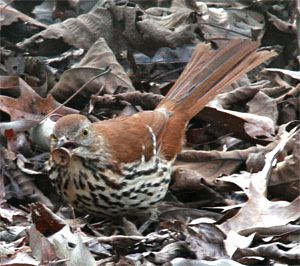 followed by dense stands of Eastern Red Cedar . . . and succeeded by mixed pine and deciduous woods that dominate our 11 acres today.
followed by dense stands of Eastern Red Cedar . . . and succeeded by mixed pine and deciduous woods that dominate our 11 acres today. 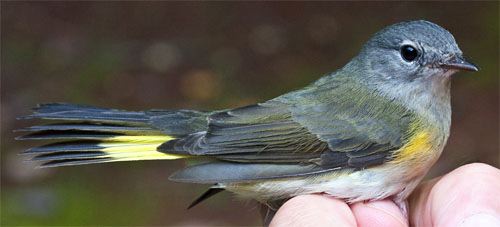
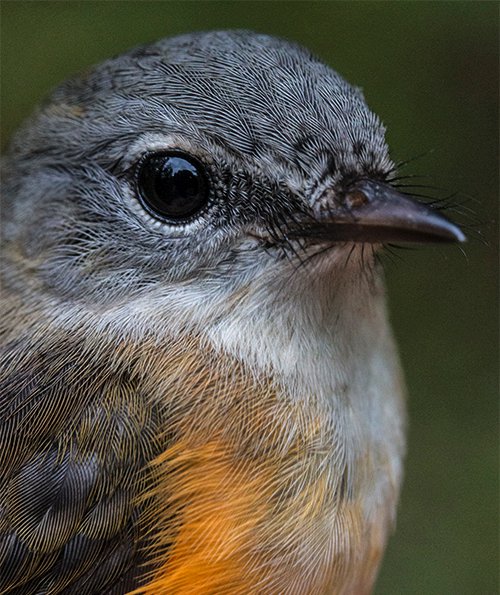
 The mature male also shows a prominent orange wing spot. Ornithologists believe bright tail spots on all ages and sexes of AMRE are used to flush prey from hiding spots among leaves and twigs, making them easier pickings. Hilton Pond Center is barely withing the breeding range for American Redstarts, which nest more commonly to the west and north into Canada's northern provinces. Nearly all redstarts spend the winter in Central America, the Caribbean, or northern South America.
The mature male also shows a prominent orange wing spot. Ornithologists believe bright tail spots on all ages and sexes of AMRE are used to flush prey from hiding spots among leaves and twigs, making them easier pickings. Hilton Pond Center is barely withing the breeding range for American Redstarts, which nest more commonly to the west and north into Canada's northern provinces. Nearly all redstarts spend the winter in Central America, the Caribbean, or northern South America.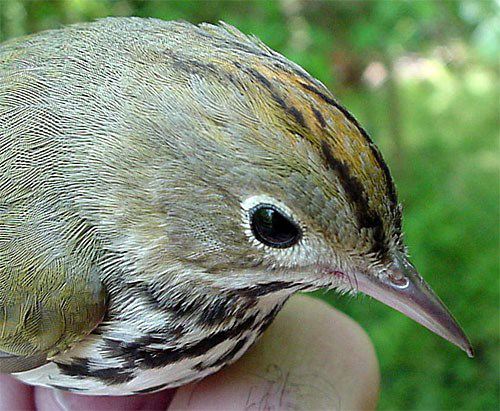
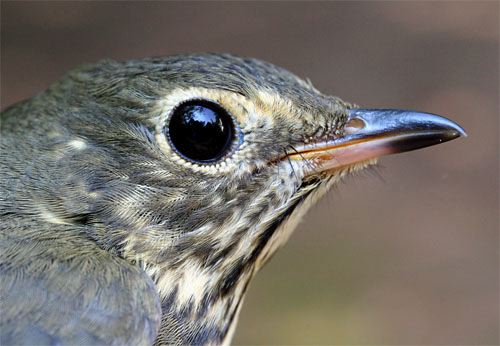
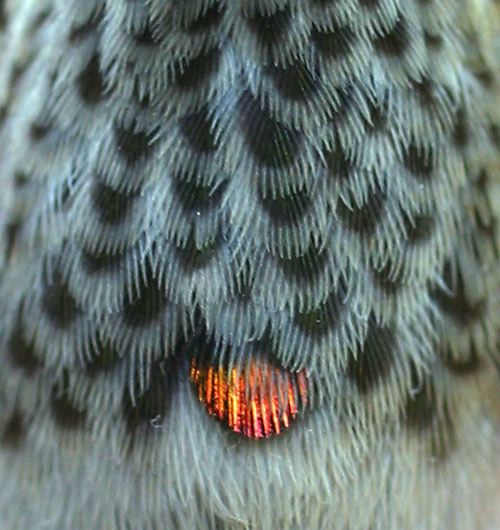
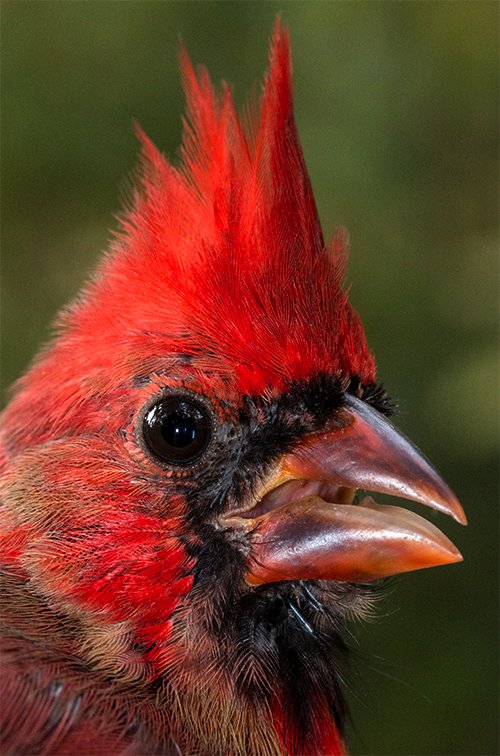
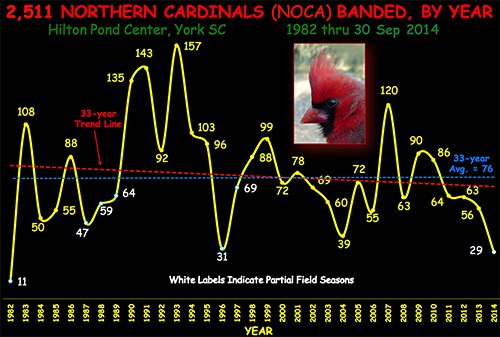

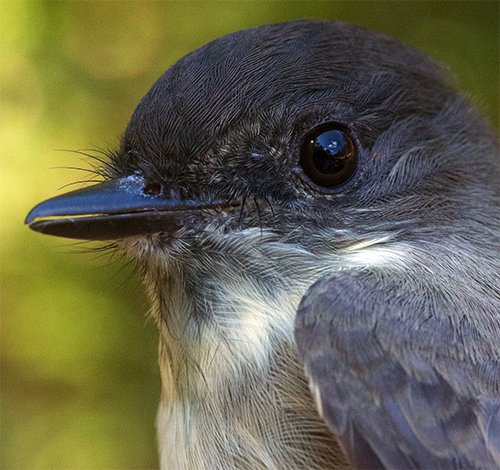
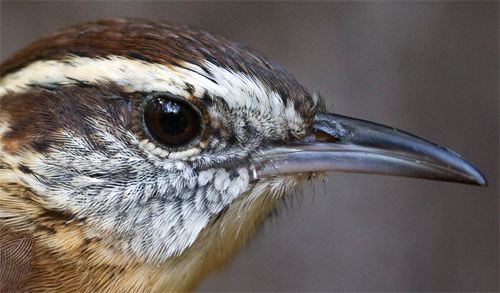
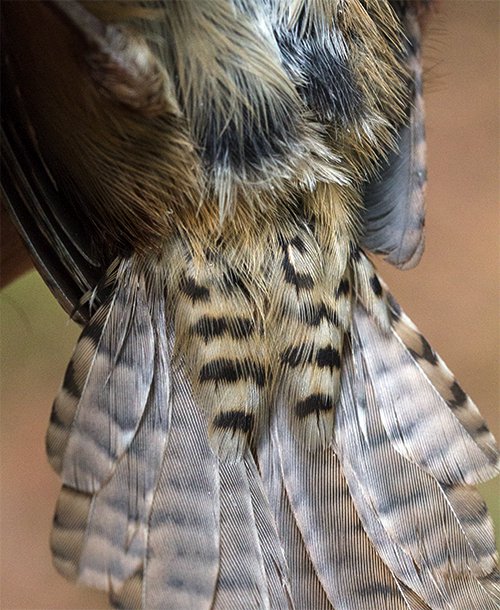
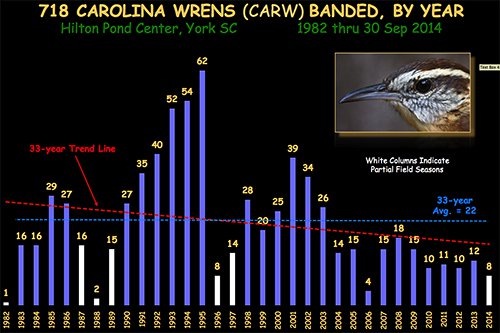
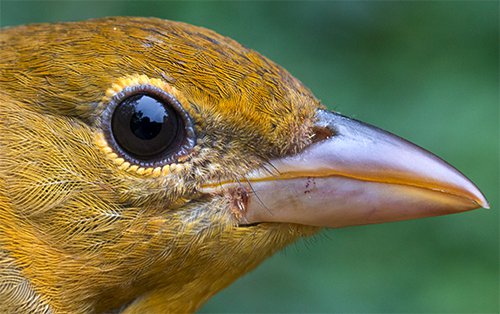
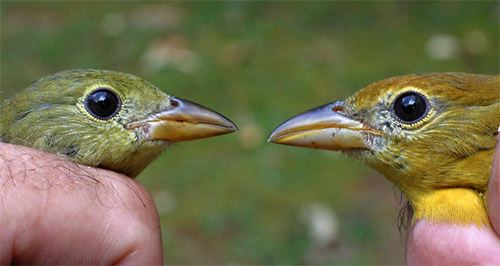


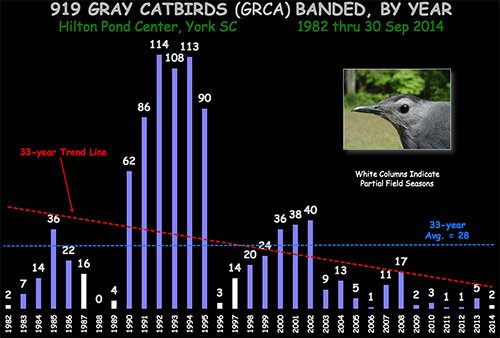
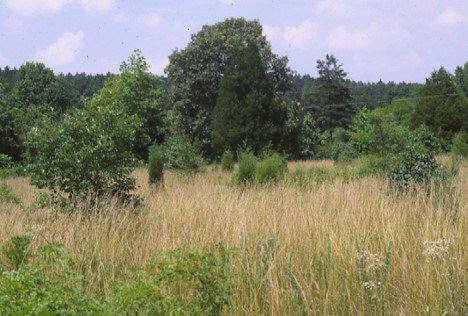








 Please report your
Please report your Oct 15 to Mar 15:
Oct 15 to Mar 15: